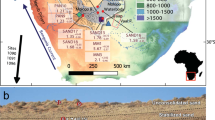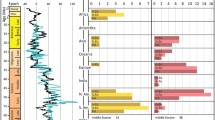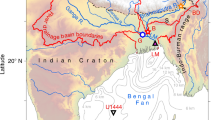Abstract
The Namib Sand Sea is one of the world’s oldest and largest sand deserts1, yet little is known about the source of the sand in this, or other large deserts2. In particular, it is unclear whether the sand is derived from local sediment or comes from remote sources. The relatively uniform appearance of dune sands and low compositional variability within dune fields3 make it difficult to address this question. Here we combine cosmogenic-nuclide measurements and geochronological techniques to assess the provenance and migration history of sand grains in the Namib Sand Sea. We use U–Pb geochronology of detrital zircons to show that the primary source of sand is the Orange River at the southern edge of the Namib desert. Our burial ages obtained from measurements of the cosmogenic nuclides 10Be, 26Al and 21Ne suggest that the residence time of sand within the sand sea is at least one million years. We therefore conclude that, despite large climatic changes in the Namib region associated with Quaternary glacial–interglacial cycles4,5, the area currently occupied by the Namib Sand Sea has never been entirely devoid of sand during the past million years.
This is a preview of subscription content, access via your institution
Access options
Subscribe to this journal
Receive 12 print issues and online access
$259.00 per year
only $21.58 per issue
Buy this article
- Purchase on Springer Link
- Instant access to full article PDF
Prices may be subject to local taxes which are calculated during checkout

Similar content being viewed by others
References
Ward, J., Seely, M. & Lancaster, N. On the antiquity of the Namib. S. Afr. J. Sci. 79, 175–183 (1983).
Pell, S. D., Williams, I. S. & Chivas, A. R. The use of protolith zircon-age fingerprints in determining the protosource areas for some Australian dune sands. Sedim. Geol. 109, 233–260 (1997).
Muhs, D. Mineralogical maturity in dunefields of North America, Africa and Australia. Geomorphology 59, 247–269 (2004).
Besler, H. Die dünen-Namib: Entstehung und dynamik eines Ergs. Stuttgarter Geographische Studien, Geographisches Institut der Universität Stuttgart 96, 145 (1980).
Partridge, T. The evidence for Cainozoic aridification in southern Africa. Quat. Int. 17, 105–110 (1993).
McKee, E. Sedimentary structures in dunes of the Namib Desert, South West Africa. Geol. Soc. Am. Spec. Pap. 188 (1982).
Lancaster, N. The Namib Sand Sea—Dune Forms, Processes and Sediments (Balkema, 1989).
Bierman, P. R. & Caffee, M. Slow rates of rock surface erosion and sediment production across the Namib Desert and Escarpment, Southern Africa. Am. J. Sci. 301, 326–358 (2001).
Van der Wateren, F. M. & Dunai, T. J. Late Neogene passive margin denudation history—cosmogenic isotope measurements from the central Namib desert. Glob. Planet. Change 30, 271–307 (2001).
Bristow, C. S., Duller, G. A. T. & Lancaster, N. Age and dynamics of linear dunes in the Namib Desert. Geology 35, 555–558 (2007).
Forman, S., Oglesby, R. & Webb, R. Temporal and spatial patterns of Holocene dune activity on the Great Plains of North America: megadroughts and climate links. Glob. Planet. Change 29, 1–29 (2001).
Granger, D. E. & Muzikar, P. F. Dating sediment burial with in situ-produced cosmogenic nuclides: Theory, techniques, and limitations. Earth Planet. Sci. Lett. 188, 269–281 (2001).
Fujioka, T., Chappell, J., Fifield, L. K. & Rhodes, E. J. Australian desert dune fields initiated with Pliocene–Pleistocene global climatic shift. Geology 37, 51–54 (2009).
Granger, D. E., Kirchner, J. W. & Finkel, R. Spatially averaged long-term erosion rates measured from in situ-produced cosmogenic nuclides in alluvial sediment. J. Geol. 104, 249–257 (1996).
Lancaster, N. Winds and sand movement in the Namib Sand Sea. Earth Surf. Process. Landf. 10, 607–619 (1985).
Klein, J. et al. Revealing histories of exposure using in situ produced 26Al and 10Be in Libyan desert glass. Radiocarbon 28, 547–555 (1986).
Rogers, J. Sedimentation on the continental margin off the Orange River and the Namib desert. Joint Geol. Surv./UCT Mar. Geosci. Group Bull. 7 (1977).
Lancaster, N. & Ollier, C. Sources of sand for the Namib Sand Sea. Z. Geomorph. Suppl. 45, 71–83 (1983).
Johnson, M. Sandstone petrography, provenance and plate tectonic setting in Gondwana context of the southeastern Cape–Karoo Basin. S. Afr. J. Geol. 94, 137–154 (1991).
Chase, B. M. et al. A record of rapid Holocene climate change preserved in hyrax middens from southwestern Africa. Geology 37, 703–706 (2009).
Sole, C. L., Scholtz, C. H. & Bastos, A. D. S. Phylogeography of the Namib Desert dung beetles Scarabaeus (Pachysoma) MacLeay (Coleoptera: Scarabaeidae). J. Biogeogr. 32, 75–84 (2005).
Lal, D. Cosmic ray labelling of erosion surfaces: In situ nuclide production rates and erosion models. Earth Planet. Sci. Lett. 104, 424–439 (1991).
Dickinson, W. W. & Ward, J. D. Low depositional porosity in eolian sands and sandstones, Namib desert. J. Sedim. Res. A64, 226–232 (1994).
Vermeesch, P. CosmoCalc: An Excel add-in for cosmogenic nuclide calculations. Geochem. Geophys. Geosyst. 8, Q08003 (2007).
Dunai, T. Scaling factors for production rates of in situ produced cosmogenic nuclides: A critical reevaluation. Earth Planet. Sci. Lett. 176, 157–169 (2000).
Acknowledgements
This work was funded by a Marie Curie postdoctoral fellowship at ETH-Zürich in the framework of the CRONUS-EU network (RTN reference 511927), a faculty research grant at Birkbeck, University of London, and a NERC CIAF grant (allocation no 9059.1008), all awarded to P.V. We would like to thank H. Kolb of the Gobabeb Desert Research Centre for his dune-driving skills, H. Schreiber and P. Swiegers for granting access to their land for sampling, A. Davidson, H. Baur and A. Carter for technical/laboratory assistance and R. Wieler for feedback.
Author information
Authors and Affiliations
Contributions
P.V. designed the study, collected the samples, carried out the U–Pb analyses and wrote the paper; C.R.F. made the 10Be and 26Al measurements; F.K. carried out the noble gas analyses; G.F.S.W. provided field assistance; C.S.B. helped in writing the paper; S.X. was in charge of the accelerator mass spectrometer measurements.
Corresponding author
Ethics declarations
Competing interests
The authors declare no competing financial interests.
Supplementary information
Supplementary Information
Supplementary Information (PDF 336 kb)
Rights and permissions
About this article
Cite this article
Vermeesch, P., Fenton, C., Kober, F. et al. Sand residence times of one million years in the Namib Sand Sea from cosmogenic nuclides. Nature Geosci 3, 862–865 (2010). https://doi.org/10.1038/ngeo985
Received:
Accepted:
Published:
Issue Date:
DOI: https://doi.org/10.1038/ngeo985
This article is cited by
-
What sets aeolian dune height?
Nature Communications (2022)
-
21st-century stagnation in unvegetated sand-sea activity
Nature Communications (2022)
-
Eolian chronology reveals causal links between tectonics, climate, and erg generation
Nature Communications (2022)
-
Implications for sedimentary transport processes in southwestern Africa: a combined zircon morphology and age study including extensive geochronology databases
International Journal of Earth Sciences (2022)
-
Unravelling raked linear dunes to explain the coexistence of bedforms in complex dunefields
Nature Communications (2017)




